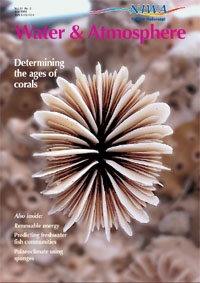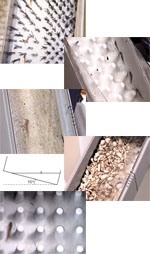PDF of this article (1 MB)

Cindy Baker Jacques Boubée
Experimental work is helping to identify the types of fish ramps that will most likely help migratory fish get past low barriers in streams.




Close to half our native freshwater fish are diadromous, with part of their life cycle spent at sea and part in fresh water. During spring and summer swarms of juvenile fish migrate from the sea into our rivers and streams seeking adult habitat. Perhaps the best-known fish migrations are the whitebait runs, which make up a very important fishery in many rivers.
But migration upstream is not always easy for fish, as many barriers can block their passage. These include natural barriers like waterfalls and debris jams, but also artificial barriers such as dams, culverts and weirs. Some migratory species can climb the wetted margins of waterfalls, spillways, culverts and weirs to successfully surmount such obstacles – for example, see “The key to climbing in koaro” in Water & Atmosphere 11(1). Other fish species must swim past such obstacles, relying on short bursts of fast swimming to get past high-velocity areas. In most cases, swimming fish are less successful than climbing species in negotiating in-stream obstacles. Barriers to migration can restrict fish distributions, which may ultimately lead to a decline in adult stocks or reduced biodiversity. Therefore when building artificial barriers, it is important to include some means to allow migratory fish to get past easily. What is the best way of doing this?
Fish ramps – a simple solution
Ramps may be a simple way of ensuring successful passage past obstacles in streams. Recent studies by NIWA have investigated the effects of ramp slope and surface type on fish passage. We tested adults and juveniles of two native diadromous fish species: inanga and redfin bullies. Inanga (the main whitebait species) are swimming fish and are easily hindered by in-stream obstacles. Redfin bullies are thought to possess both swimming and climbing abilities. We tested all the fish on ramps 2 m long and 0.4 m wide, and lined with five kinds of surface: gravel, sand, bristles, plastic moulds similar to egg cartons, and plastic moulds of rounded cones on a flat surface (stripdrain).
A ramp with no attached substrate (a smooth, bare surface) was also tested. The plastic mouldings and the bristles (to an extent) create low-velocity areas behind each protrusion that may allow swimming fish to rest. Sand and gravel provide a rough surface, which reduces water velocities over the ramp.
We set each type of ramp at slopes of 15°, 30° and 45°. As a wetted margin may be important for climbing fish passage, we tilted the ramps sideways at an angle of 10°. This provided deeper water for swimming fish, as well as a wetted margin to aid climbing species. The flow was 1.1 litres/second for all ramps and slopes tested except for the egg-carton ramp, on which we reduced the flow to 0.26 litres/second at slopes of 30° and 45° to maintain a wetted margin. For each trial, we placed 50 fish at the base of each ramp and gave them 3 hours to pass the ramp. We conducted five trials on each ramp at each slope.
Adult and juvenile inanga
Most inanga would begin swimming in the main current at the base of the ramp. As they swam up the ramp, fish would move back and forth from the deeper, faster water to the shallower, slower water with no apparent pattern. Therefore successful passage up the ramp occurred when a fish happened to try out a path within its swimming ability.
On the bristles, egg-carton, gravel and sometimes the sand surfaces, fish could rest on the wetted margin (see ramp surfaces tested, above). Most of the fish resting were adult inanga; we saw juveniles resting only on the gravel ramp.
More than 75% of juvenile inanga successfully negotiated all ramps at a 15° slope, except for the bare ramp, which had only a 50% success rate (upper graph, above). When the slope was increased to 30°, the fish did best on the stripdrain, gravel and egg-carton ramps, but this was less than 30%. At a slope of 45°, no juveniles could negotiate any of the ramps tested. We observed a similar pattern with adult inanga except that the adults had more success on the stripdrain surface, which was the only 45° surface that adult inanga could surmount (middle graph, above). More juveniles than adults passed over the sand and bare ramps with 15° slopes. This may be because they could use the very shallow, slow water margins, while adults were forced into the deeper and therefore faster flow.
Adult and juvenile redfin bullies
Redfin bullies could swim up ramps with only 15° slopes. However, at slopes of 30° and 45° they climbed. In fact, they could climb the shallow, wetted margins of all the ramps. When climbing, bullies performed a breast-stroke movement, propelling themselves forward with their large pectoral fins and then adhering to the surface with the pectoral fins. Juvenile and adult fish were equally good climbers.
Around 60% of bullies successfully negotiated most ramps with slopes of 15°. The stripdrain surface gave the best success rate and the bare ramp the lowest. This was probably because the protruding cones on the stripdrain decreased water velocities and increased water depths within the channels, allowing the bullies to swim along the margins rather than climb. Because the fish climbed quite slowly 3 hours were insufficient for all fish to climb the ramps. Given longer, more bullies would have successfully negotiated the gravel, bristles, sand and egg-carton ramps.
Because of their climbing ability, redfin bullies could scale all ramps at 45°, except the bare ramp, which was only scaled when the slope was 15°. This suggests that bullies may prefer a “rougher” surface to aid adhesion.
Conclusions
Overall, the stripdrain surface provided the most successful passage for both inanga and bullies. Stripdrain was successful because it reduced water velocities more than the other surfaces. However, fish could not rest behind the cones. Altering the distance between the cones to provide rest areas for fish may further increase passage success. The gravel surface was also successful, allowing inanga to rest in the wetted margin during passage. It also provides a more natural surface that is less likely to clog with debris. However, this surface was not very effective for inanga passage at slopes of 30° and higher. We believe that the presence of a wetted margin is essential, as it provides rest areas for swimming fish and a wet surface for climbing species.
The results of these experiments provide useful information in designing ramps for fish passage past small barriers such as culverts and weirs. Ramps can ensure that the annual upstream migrations of native fish are unimpeded by small in-stream obstacles.
Teachers: this article can be used for NCEA Achievement Standards in Biology (1.2, 2.2, 3.4). See other curriculum connections at www.niwa.co.nz/pubs/wa/resources
Cindy Baker and Jacques Boubée are based at NIWA in Hamilton.
See for yourself
| redfin bullies stripdrain ramp | low res (2.86 Mb) | high res (30.99 Mb) |
|---|---|---|
| inanga bare ramp | low res (2.03 Mb) | high res (38.25 Mb) |
| inanga brush ramp | low res (6.32 Mb) | high res (42.97 Mb) |
| inanga egg carton ramp | low res (2.83 Mb) | high res (37.86 Mb) |
| inanga gravel ramp | low res (4.75 Mb) | high res (33.47 Mb) |
| inanga sand ramp | low res (898 Kb) | high res (12.14 Mb) |
